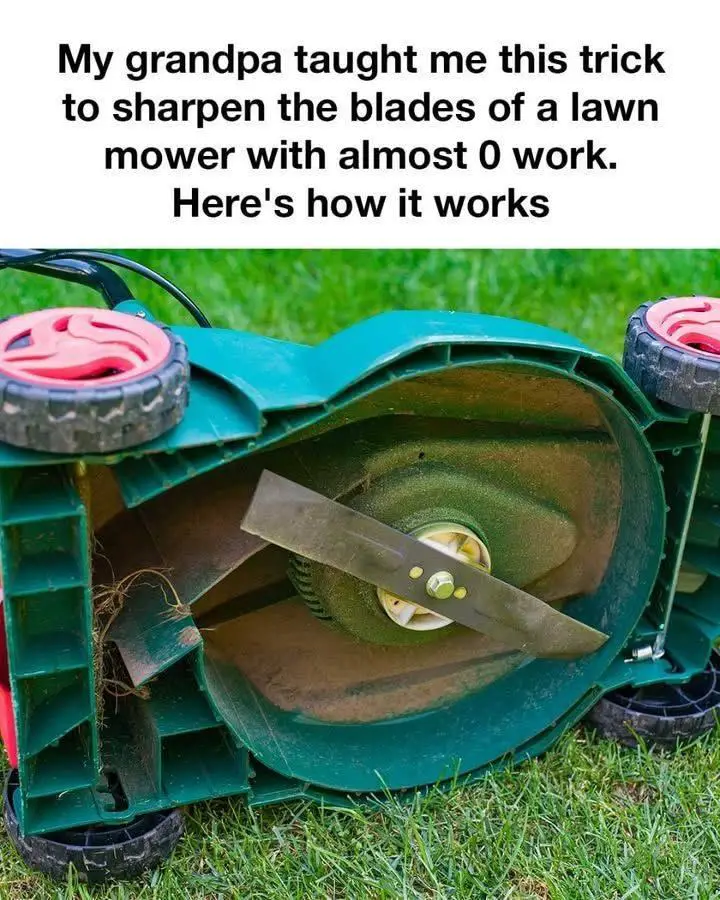Here’s a more polished, engaging, and reader-friendly version of your article—retaining your personal touch and practical advice while enhancing clarity and flow:
✂️ The Lawn Mower Blade Sharpening Trick My Grandpa Swore By
(It Only Takes 15 Minutes!)
Lawn mower maintenance is something every proud homeowner tackles sooner or later. Oil changes, spark plugs, fuel—those are the usual suspects. But there’s one task most people overlook: sharpening the mower blades.
Dull blades don’t just make your mower less effective—they actually harm your grass. Instead of slicing cleanly, dull blades tear the grass, leaving behind frayed, brown-tipped blades that invite pests and disease. Fortunately, my grandpa passed down a surprisingly simple trick that keeps blades razor-sharp with barely any effort—and no fancy equipment.
🌱 Why Sharp Blades Make All the Difference
Sharp blades:
- Cut cleanly, promoting healthier grass.
- Prevent browning and damage caused by torn edges.
- Reduce stress on your mower’s engine, extending its lifespan.
- Give your lawn that crisp, golf-course look every time you mow.
Blunt blades, on the other hand, create a patchy, weak lawn—and make mowing harder than it needs to be.
🧰 What You’ll Need
- A strip of medium-grit sandpaper
- WD-40 or any general-purpose lubricant
- A socket wrench set (sized for your mower’s bolts)
- A wooden block (acts as your sharpening base)
- Protective gloves
No grinders. No workshops. Just tools you likely already have in your garage.
🔧 Grandpa’s Easy Blade-Sharpening Trick
Step 1: Tip your mower onto its side.
Make sure the air filter and carburetor are facing up to avoid gas or oil spills.
Step 2: Use the socket wrench to remove the blade.
Gloves are highly recommended—those blades are sharper than they look.
Step 3: Spray WD-40 onto your sandpaper.
Lay the sandpaper flat over the wooden block for a stable surface.
Step 4: Gently run the blade across the sandpaper, maintaining the existing angle.
You’re not trying to make it razor-thin—just restore a clean edge. A few even strokes on each side will do the trick.
Step 5: Reattach the blade securely and upright the mower.
Tighten the bolts firmly and double-check everything before starting the engine.
Total time? About 15 minutes. The difference in your lawn’s health and appearance? Immediate.
🛑 Safety First: Read Before You Sharpen
- Always disconnect the spark plug (or battery, for electric mowers) before working.
- Wear gloves to protect your hands while removing or handling the blade.
- Work slowly and carefully—no need to rush when dealing with sharp metal.
🔁 How Often Should You Sharpen Mower Blades?
A good rule of thumb is to sharpen your blades:
- Every 20–25 hours of mowing time
- Or at the start and midpoint of each mowing season
If you hit a lot of twigs, rocks, or roots, you might need to sharpen more often.
🛠️ Other Sharpening Options (If You Prefer Alternatives)
- Bench grinder – fast but requires a steady hand
- Sharpening stone – inexpensive but time-consuming
- Professional service – effective, but often overkill for regular maintenance
Still, for most homeowners, Grandpa’s sandpaper trick is more than enough to keep things razor-sharp.
⚖️ Bonus Tip: Don’t Forget Blade Balance
After sharpening, check that the blade is evenly weighted. An unbalanced blade can cause vibration and wear down your mower.
Just hammer a nail into a wall, hang the blade through its center hole, and see if either end dips. If it’s lopsided, file the heavier side until it balances.
🌿 Final Thoughts: Sharpen Once, Enjoy All Season
There’s something deeply satisfying about mowing with a sharp, smooth blade. You glide across the lawn, the engine hums effortlessly, and the result is a yard that looks like it belongs in a magazine. And with just a bit of sandpaper and Grandpa’s wisdom, you can make that happen anytime.
No stress. No gadgets. Just results.
Would you like a printable checklist or graphic for this sharpening method?
